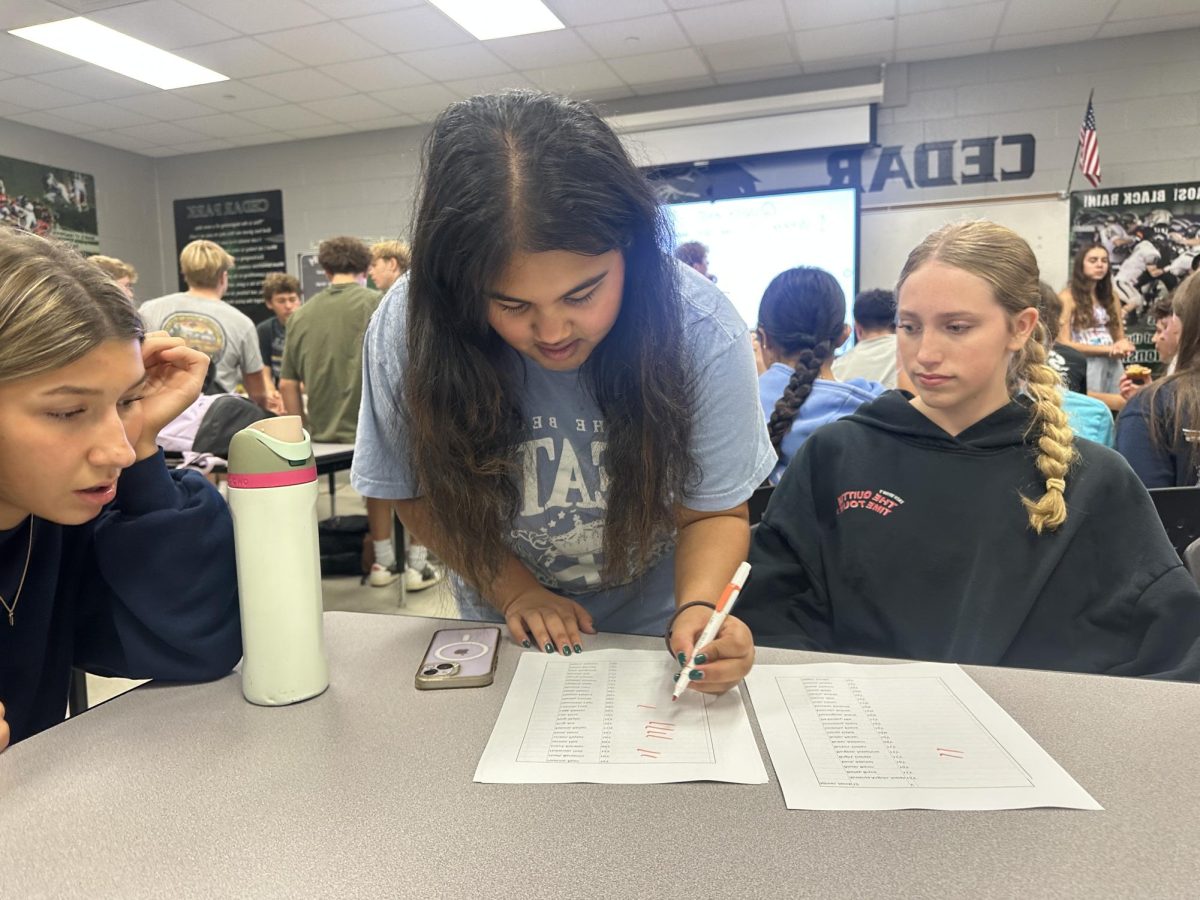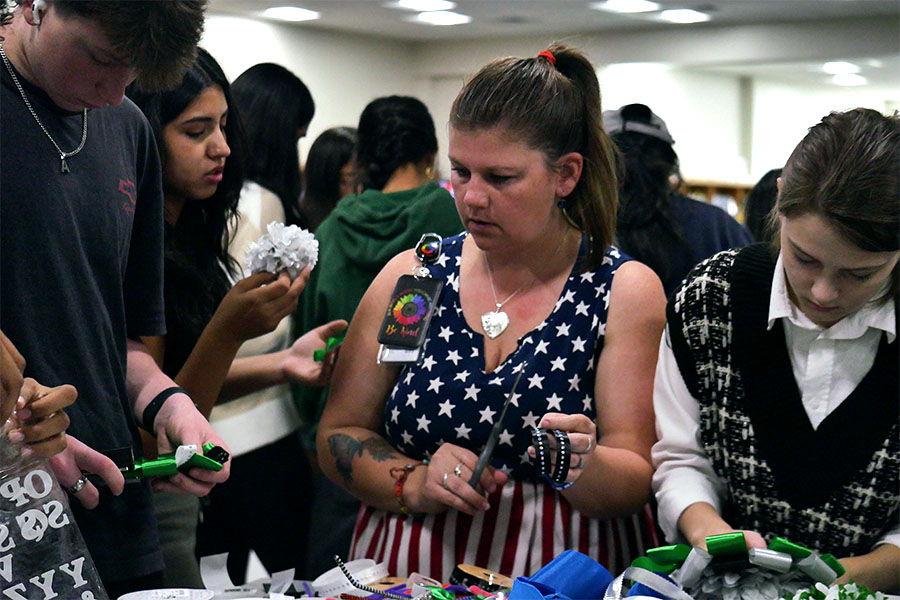With two snow flurries in one school year and weather that feels even more frigid than normal, it should come as no surprise to anybody that this winter is, in fact, colder than usual. This strange cold snap has wreaked all sorts of havoc across the globe.
Students have been buzzing with excitement about the uncharacteristically low temperatures and amount of snowfall in Cedar Park. Those from up north welcome the change:
“It’s really exciting, because I’m from Michigan and it never gets this cold down here,” Taylor Datzko, sophomore, said.
Other students were not so ecstatic about the weather. Students that partake in such extracurricular activities as softball have to keep an eye out for the weather, because extreme temperatures could have devastating effects on the field and game play.
“A lot of our practices have been cut, and our first scrimmage was rained out,” Jessica Garrett, junior softball player, said. “The weather can be really bad for the field, and it can hurt really badly when you hit the ball.”
The most surprising aspect of this weather is the extent to which it has reached in the southern United States. As far south as Florida, farmers of citrus and berry fruits prepared for a freeze, the length of which was unlike anybody has seen in over twenty years. There were reports of steam rising from the Gulf of Mexico in the Panhandle of Florida as the chilly air hit the warm water.
In northern states such as New York and Vermont, snow came down as thick as thirty-three inches- the most snow in a single storm ever recorded since 1969. Northeastern schools were often closed or had their holiday break extended, in addition to establishments like nuclear power plants being shut down. Ground travel was delayed throughout the north as Amtrak systems temporarily ceased operation due to drifting snow, and airports added to these delays as crews had to de-ice equipment before takeoff to ensure safe flights.
Even more devastating was the high death toll in the United States. Many of these horrific deaths were those of the homeless who suffered the freezing conditions without shelter, particularly in southern states where people are not accustomed to long and harsh winter storms. Shelters and churches who seek to help people in such bleak situations had as many as three times their usual occupants, and larger shelters that normally house up to 800 occupants were filled beyond maximum capacity.
The chilly weather did not only effect the United States, nor did it bring nearly as much damage. The United Kingdom faced its coldest winter in a century, with recorded temperatures of sixteen degrees below zero and no sign of relief until mid-January. Hundreds of flights were cancelled, and over 2000 people were stuck in the Channel Tunnel, some overnight, as five trains failed. The trains of the underwater tunnel had electrical mishaps due to the freezing conditions, and many families and individuals were stranded for hours without food or water.
All across Europe deaths in the hundreds were reported; similarly to the United States, these deaths were often those of homeless individuals with no shelter from the cold, nor proper clothing or supplies to protect themselves from it. Even higher was the rate of automotive failures resulting in more casualties.
Speculations about the end to the global warming scare popped up everywhere as meteorologists and scientists studied the patterns of this weather. Students began to comment on the possibility of change in the widely-accepted theory.
“It’s getting colder, so it’s obviously disproving global warming,” Dylan Rolfe, junior, said.
Other students concluded that mankind’s tampering with the environment resulting in phenomena such as climate change, and that the Arctic chill was only a part of the process.
“It’s global warming’s fault. It’s society’s fault for releasing gases into the air; we need to start recycling and helping our planet,” Bianca Rodriguez, senior, said.
Some specialists have suggested that the weather is merely a stronger occurrence of a very routine air flow pattern throughout the globe. While air flow from the Arctic is normally kept at bay by river-like currents of air that separate the Arctic region and the tropics, the currents will sometimes naturally begin to flow in more of a zigzag pattern, resulting in the exposure of some regions to the harsh winds of the Arctic.
The reasons why this particular occurrence of the phenomenon has been so devastating are not clear, but Texans know that warmer temperatures can’t be too far away.










![Broadcast, yearbook and newspaper combined for 66 Interscholastic League Press Conference awards this year. Yearbook won 43, newspaper won 14 and broadcast took home nine. “I think [the ILPC awards] are a great way to give the kids some acknowledgement for all of their hard work,” newspaper and yearbook adviser Paige Hert said. “They typically spend the year covering everyone else’s big moments, so it’s really cool for them to be celebrated so many times and in so many different ways.”](https://cphswolfpack.com/wp-content/uploads/2025/05/edited-ILPC.jpg)





![Looking down at his racket, junior Hasun Nguyen hits the green tennis ball. Hasun has played tennis since he was 9 years old, and he is on the varsity team. "I feel like it’s not really appreciated in America as much, but [tennis] is a really competitive and mentally challenging sport,” Nguyen said. “I’m really level-headed and can keep my cool during a match, and that helps me play a bit better under pressure.” Photo by Kyra Cox](https://cphswolfpack.com/wp-content/uploads/2025/09/hasun.jpg)

![Bringing her arm over her head and taking a quick breath, junior Lauren Lucas swims the final laps of the 500 freestyle at the regionals swimming competition on date. Lucas broke the school’s 18-year-old record for the 500 freestyle at regionals and again at state with a time of 4:58.63. “I’d had my eye on that 500 record since my freshman year, so I was really excited to see if I could get it at regionals or districts,” Lucas said. “ State is always a really fun experience and medaling for the first time was really great. It was a very very tight race, [so] I was a bit surprised [that I medaled]. [There were] a lot of fast girls at the meet in general, [and] it was like a dogfight back and forth, back and forth.” Photo by Kaydence Wilkinson](https://cphswolfpack.com/wp-content/uploads/2025/03/Kaydence-2.7-23-edit-2.jpg)
![As her hair blows in the wind, senior Brianna Grandow runs the varsity girls 5K at the cross country district meet last Thursday. Grandow finished fourth in the event and led the varsity girls to regionals with a third place placement as a team. “I’m very excited [to go to regionals],” Grandow said. “I’m excited to race in Corpus Christi, and we get to go to the beach, so that’s really awesome.” Photo by Addison Bruce](https://cphswolfpack.com/wp-content/uploads/2025/10/brianna.jpg)











